Pruning Landscape Plants
Pruning is one of the least understood practices of landscape maintenance. Before trying to prune your landscape shrubs and trees, consider the basic principles of pruning. Review the following considerations before starting to prune your landscape plants.
Reasons for Pruning
- Control the size and shape of a plant to keep it from overpowering the landscape.
- Remove undesirable growth that distracts from plant balance or symmetry.
- Remove diseased, insect-infested, dead, or abnormal plant tissue.
- Stimulate flowering and/or fruit production of older plants.
- Develop a specific plant form, such as a hedge, topiary, or espalier, as in formal landscape designs.
- Direct or train trees to grow in a particular form to eliminate problems.
- Remove plant parts that may interfere with structures or utility lines or that may create a visibility problem.
How to Prune
How to prune depends on the plant type. Most woody landscape plants can be put in one of these categories: broadleaf evergreens, narrowleaf evergreens, or deciduous plants. Each type has specific responses to pruning. Know your plant type before pruning.
The shedding of old leaves and the growth of new ones on evergreen plants are timed so the plant is rarely, if ever, without leaves. That is why we call these plants evergreen.
Broadleaf evergreen plants are the most popular landscape plants used in the South. They have broad, wide, or flat leaves. Examples of broadleaf evergreen plants are hollies, ligustrum (privet), photinia (red tip), elaeagnus, euonymus, cleyera, azaleas, pyracantha, nandina, gardenia, pittosporum, sweet olive, boxwood, camellia, aucuba, mahonia, fatsia, and southern magnolia.
Along the limbs, branches, and trunks of broadleaf evergreen plants are specialized cells (latent buds) that can become growing buds. A latent bud remains dormant until stimulated into growth. If these latent buds are present, you can prune the plant drastically and not worry about killing it.
Some broadleaf evergreens may be dwarf plants. Dwarf plants normally have a compact, dense growth habit and do not need much pruning to control size or shape. “Dwarf “ means that the plant is smaller than the standard version. For example, the standard yaupon can reach 20 feet tall, whereas the dwarf yaupon reaches only 4 to 6 feet tall. You can tip-prune to encourage a thick, well-shaped plant, but after many years, some dwarf shrubs may need rejuvenating. They can be pruned severely (cut to 6 to 12 inches from the ground) with satisfactory results. Prune this way in early spring, before new growth begins.
Narrowleaf evergreens have tiny, scale-like or needle-like leaves, and many produce cones. That is why we call them conifers. Examples are junipers, arborvitae, pine, cedar, hemlock, and spruce. Narrowleaf evergreen shrubs need occasional foliage shearing in early spring to control size. Narrowleaf evergreens do not have latent buds, so you can’t prune them as severely as broadleaf evergreens. Narrowleaf evergreens often are thought of as having a “dead zone” on the older parts of the branches. If you remove all the scales or needles with a pruning cut, no new growth will occur on the remaining limb. Drastic pruning of narrowleaf evergreen plants can kill them. To avoid the “dead zone,” never remove more than one-third of the foliage of a narrowleaf evergreen.
Prune conifers, such as pines, by removing a portion of the candle-like new growth on the tips of pines in early spring. Once the so-called candle has matured, the buds on it won’t usually develop and grow. But removing the tip of the candle before it matures can stimulate buds into growth.
Deciduous landscape plants shed their leaves in the fall. Like broadleaf evergreens, deciduous plants can be severely pruned without fear of killing them.
Deciduous plants may be shrubs, trees, or vines. Some common deciduous shrubs and trees used in Mississippi landscapes include forsythia, spiraea, weigela, lilac, rose, crape myrtle, quince, honeysuckle, hydrangea, oak, maple, and poplar. Deciduous shrubs may need pruning to control their size and shape. Light to moderate tip-pruning encourages thick new growth, resulting in bushy plants. Deciduous plants may also be pruned by rejuvenation and thinning. You would normally do this before new growth begins in the spring.
Pruning Methods
Tip-pruning encourages a thick, well-shaped plant. Light tip-pruning removes only a few inches of stem tips and is usually done in early spring after new growth has occurred.
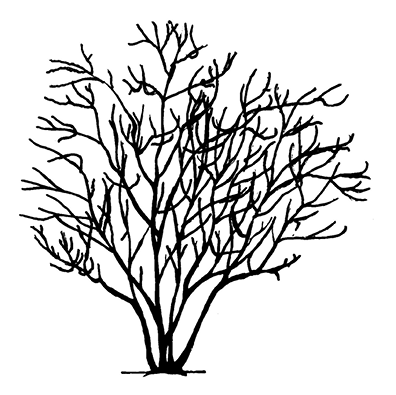
Thinning is used on broadleaf, deciduous landscape plants to encourage flowering and strong growth. Thin in early spring before new growth begins by removing older or weaker branches back to a lateral branch or completely to the ground.
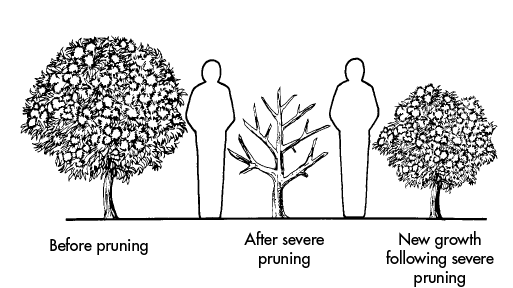
Shearing controls the shape and size of all types of shrubs. Shearing calls for clipping the newest foliage, usually 1 to 2 inches of new growth. Shearing is actually a type of tip-pruning that removes minimal foliage. Broadleaf evergreen hedges and screens are often sheared to promote thick, dense foliage. Always use sharp shears.
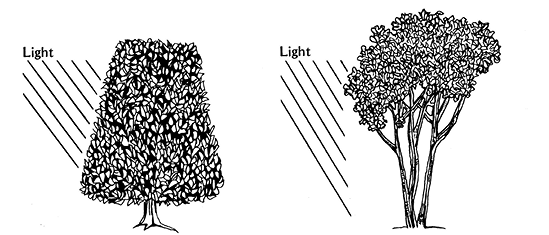
Rejuvenation is severe pruning used only on broadleaf evergreens and deciduous plants to control overgrown, leggy, and straggly plants. Use this method of pruning in early spring before the beginning of new growth. A special form of rejuvenation pruning is used for clump-forming shrubs, such as nandina and mahonia. One-third of the oldest limbs are removed each year.
Espalier plants are trained to grow against a wall. A tall wall is best for espaliered plants. Pruning may be necessary several times throughout the growing season to get the desired shape and form.
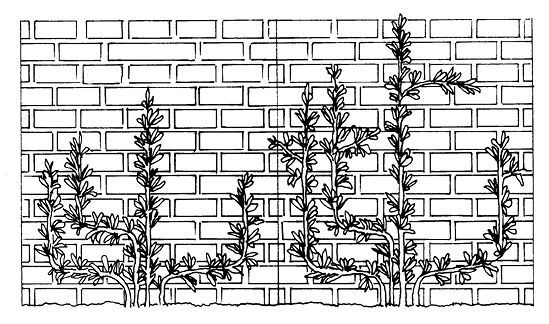
Topiary is the art of shaping plants into fantastic or ornamental forms by careful pruning or trimming. Topairy pruning may be necessary several times during the growing season. Broadleaf and narrowleaf trees and shrubs normally perform well as topiaries.
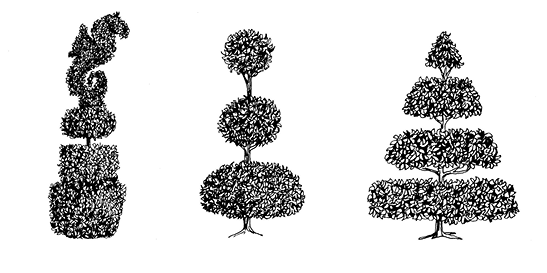
Removing tree limbs requires a special pruning technique. Tree limbs that need pruning should be cut so no stub remains. Do not remove the branch collar (D). Make three cuts as shown in the drawing. This lets the limb fall without ripping the bark down the tree trunk.
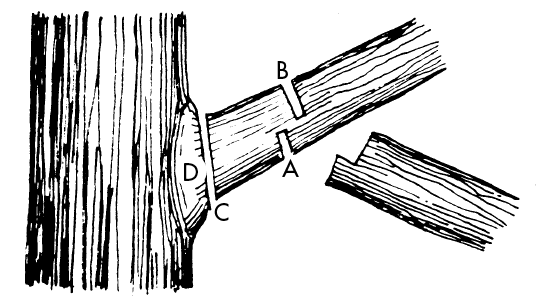
Timing
The time of year that you prune plants is important. Pruning at the wrong time may stimulate new growth that could be damaged by early frosts or freezes. It could also remove flower buds that have formed, reducing next year’s flowers. The following guidelines will help you prune your plants at the proper time. Most pruning is for size control and is best done in late winter through early spring (February through April).
Prune after the landscape feature of your plant has passed. For spring flowering plants, prune in late spring as the flowering season is ending. This allows for adequate growth during the summer to produce flower buds for the next year. For fall-flowering plants, such as some of the camellias, use tip-pruning or thinning. Prune as the flowering season is ending. For plants with colorful berries, prune after the berries are gone.
For plants that produce flowers on 1-year-old wood (usually those that bloom after June), such as hydrangeas, glossy abelia, and crape myrtle, cut away only branches with spent flowers, or prune (thinning method) in late winter to promote vigorous spring growth.
Easy and Safe Pruning
Plants that need pruning regularly because they have overgrown their planting space may need to be removed and replaced with one more suited to the available space.
Be sure your equipment is sharp and clean. Clean equipment helps prevent the spread of disease organisms. Sharp equipment makes cutting easier and helps avoid tearing plants.

Publication 3589 (POD-03-24)
Revised by Jeff Wilson, PhD, Assistant Professor, North Mississippi Research and Extension Center.
The Mississippi State University Extension Service is working to ensure all web content is accessible to all users. If you need assistance accessing any of our content, please email the webteam or call 662-325-2262.


